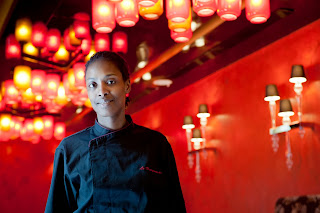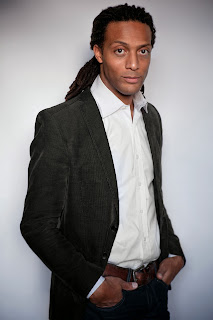The irrepressible Brian Scott Bagley heats up the stage every Wednesday night at the chic Très Honoré Bar* (also known as THB) in the 1st arrondissement.
Brian Scott Bagley
Image courtesy of Nicolas Mougenot
He partners with THB's artistic director, Rocco de Robien, to host an open mike show for amateurs and professionals in this plush nightspot that reproduces the atmosphere of a 1920s speakeasy. It is called The Buzz and audiences are sure to be buzzing when they leave Brian's electrifying productions.
Flier for the January 22 production of The Buzz
Image courtesy of Brian Scott Bagley
Brian is perhaps best known around town for his choreography and dancing in Jérôme Savary's Looking for Josephine. He also played Josephine Baker in the burlesque show La Gentry de Paris Revue with Dita von Teese. Brian is somewhat fanatical about Baker, as his 2013 Christmas video shows!
These days, Brian is not only performing at THB, but also producing his fellow Baltimore native Marvin Parks at Paris nightspots.
Parks' music is heavily influenced by singing greats such as Nat King Cole, Natalie Cole, Tony Bennett, and Sarah Vaughan. He has performed at Café Universel, L'Entrepôt, and the Duc des Lombards over the past several weeks. His most recent performance was at the Café de Paris on January 28th.
Click HERE to listen to Parks' rendition of "Summertime" from his current release The Very Thought of You. Then catch him performing live at
Le Bistro 92
92 rue de Turenne
75003 Paris
March 15 at 8 PM
and
Le Chat Noir
76, rue Jean Pierre Timbaud
75011 Paris
March 18 at 8 PM
Brian is still doing theater, with most of his shows playing in Germany and Nantes at present. He continues to do one-nighters in Paris and his risqué performances have not gone unnoticed by the press. Click HERE to see an article about his shows at THB in Le Figaro (in French).
Très Honoré Bar
35 Place du Marché St-Honoré
75001 Paris
Metro: Tuileries (Line 1)
Hours: Daily from 6:30 PM until 2 AM
*THB is associated with a restaurant and salon, both of which are at the same address and are sumptuously and fancifully decorated.
************
If you like this posting, share it with your friends by using one of the social media links below!
Image courtesy of Nicolas Mougenot
He partners with THB's artistic director, Rocco de Robien, to host an open mike show for amateurs and professionals in this plush nightspot that reproduces the atmosphere of a 1920s speakeasy. It is called The Buzz and audiences are sure to be buzzing when they leave Brian's electrifying productions.
Image courtesy of Brian Scott Bagley
Brian is perhaps best known around town for his choreography and dancing in Jérôme Savary's Looking for Josephine. He also played Josephine Baker in the burlesque show La Gentry de Paris Revue with Dita von Teese. Brian is somewhat fanatical about Baker, as his 2013 Christmas video shows!
These days, Brian is not only performing at THB, but also producing his fellow Baltimore native Marvin Parks at Paris nightspots.
Parks' music is heavily influenced by singing greats such as Nat King Cole, Natalie Cole, Tony Bennett, and Sarah Vaughan. He has performed at Café Universel, L'Entrepôt, and the Duc des Lombards over the past several weeks. His most recent performance was at the Café de Paris on January 28th.
Click HERE to listen to Parks' rendition of "Summertime" from his current release The Very Thought of You. Then catch him performing live at
Le Bistro 92
92 rue de Turenne
75003 Paris
March 15 at 8 PM
and
Le Chat Noir
76, rue Jean Pierre Timbaud
75011 Paris
March 18 at 8 PM
Brian is still doing theater, with most of his shows playing in Germany and Nantes at present. He continues to do one-nighters in Paris and his risqué performances have not gone unnoticed by the press. Click HERE to see an article about his shows at THB in Le Figaro (in French).
Très Honoré Bar
35 Place du Marché St-Honoré
75001 Paris
Metro: Tuileries (Line 1)
Hours: Daily from 6:30 PM until 2 AM
*THB is associated with a restaurant and salon, both of which are at the same address and are sumptuously and fancifully decorated.
Entrée to Black Paris!™ is a Discover Paris! blog.
If you like this posting, share it with your friends by using one of the social media links below!

















